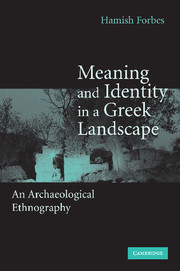Book contents
- Frontmatter
- Contents
- List of Illustrations and Tables
- Preface and Acknowledgements
- Transliteration Conventions
- 1 Introduction
- 2 Landscape Studies: From Frame-and-Tame to Visceral Feeling
- 3 Historical Background to the Landscape of Methana
- 4 Conducting Fieldwork on Methana
- 5 Kinship, Marriage and the Transmission of Names and Property
- 6 The Productive Landscape
- 7 The Historical Landscape: Memory, Monumentality and Time-Depth
- 8 The Kinship Landscape
- 9 The Religious Landscape
- 10 Conclusions: A Greek Landscape from Within
- Glossary
- Notes
- References
- Index
7 - The Historical Landscape: Memory, Monumentality and Time-Depth
Published online by Cambridge University Press: 04 May 2010
- Frontmatter
- Contents
- List of Illustrations and Tables
- Preface and Acknowledgements
- Transliteration Conventions
- 1 Introduction
- 2 Landscape Studies: From Frame-and-Tame to Visceral Feeling
- 3 Historical Background to the Landscape of Methana
- 4 Conducting Fieldwork on Methana
- 5 Kinship, Marriage and the Transmission of Names and Property
- 6 The Productive Landscape
- 7 The Historical Landscape: Memory, Monumentality and Time-Depth
- 8 The Kinship Landscape
- 9 The Religious Landscape
- 10 Conclusions: A Greek Landscape from Within
- Glossary
- Notes
- References
- Index
Summary
HF: And when did this happen?
Barba Nikos: Didn't I tell you? 1500, 1600. Now we have 1900? – 1500, 1600, 1700.
(From an interview with a nonagenarian, July 1998)OF TIME AND TIME-DEPTH
Methanites recognised that their landscape is covered with traces of past human activity. Some are archaeological sites, like Methana's ancient city, named Paleokastro – the Old Castle – for its well-preserved encircling walls and acropolis-like position. Methanites believed that a much smaller ancient acropolis-like site was the seat of a particularly brutal Agha (Turkish landowner). However, the latest archaeological material on this multiperiod site is medieval and thus pre-Turkish (Mee et al. 1997, 146–8). At the other end of the temporal scale, reminders of the past included abandoned kalivia and numerous water-storage structures – cisterns and loutses (open cisterns) – many still in regular use, scattered across the landscape. In addition, there are approximately three dozen churches of varying ages, many at substantial distances from settlements. Several retain vestiges of wall paintings in a primitive style (see fig. 9.2) and some also have ancient tiles of a type unknown over the last two centuries or so (fig. 7.1) (Koukoulis 1997b). Finally, there were the older houses in villages which also acted as monuments to past people and times.
Methanites could not date most of these reminders of past human activity: for them, the past was largely an undifferentiated blur, a homogenised block of time, comparable to the homogenisation of the sequence of ancestors prior to grandparents discussed later in this chapter.
- Type
- Chapter
- Information
- Meaning and Identity in a Greek LandscapeAn Archaeological Ethnography, pp. 207 - 285Publisher: Cambridge University PressPrint publication year: 2007



